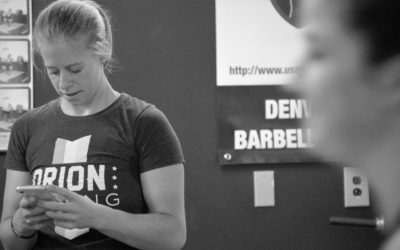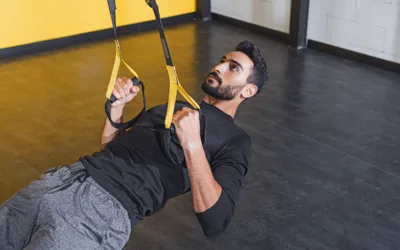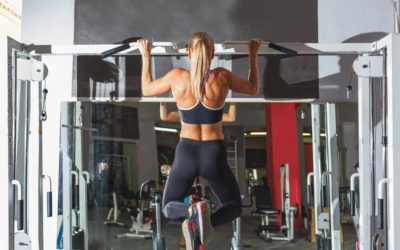5 Powerful Plyometric Exercises You Can Do Anywhere
TOPIC: Speed & Agility | Sports Performance
Is your body aging, or are you aging your body? If you’re not training for power, chances are your bones are losing density. These five simple plyometrics exercises (that can be done almost anywhere!) maximize your power, reinforce your bones, and reduce your risk of injury to keep your body alive and kicking.

Written By
kyle donsberger
Kyle Donsberger is a CSCS, lifelong athlete, and owner of Impulse Athletics. As a current member of the Canadian Skeleton Team and 2012 & 2016 Olympic Trials semi-finalist in the 400 meters, he knows a thing or two about speed training.
Website
Why You Should Do Plyometrics
As we get older, we tend to be less active and participate in less “risky” activities like jumping. However, science shows that part of why our bone density decreases with age is due to a lack of stress through the bones. In other words, you’re essentially aging yourself if you don’t continue to train your body.
Although you probably still participate in physical activities as you get older (like running or recreational sports), you likely don’t train to perform in those sports. Plyometric exercises help your body absorb and generate force in a safe environment that improves performance in the physical activities you still love to do.
Does this mean you need to start spending countless hours in the gym? Absolutely not. The best part about these plyo movements is that you don’t need any equipment to perform them! You can go out to the local park and find some grass and jump to your heart’s content.
Here’s the top five plyometric exercises you can do anytime, anywhere, to maximize your power for healthier bones, joints, and ligaments.
1. Squat Jump

The squat jump is a very simple move you can do almost anywhere – just be sure to have a little head space.
How it’s done: Stand tall on your toes and then drop down through your hips. Explode up and land in an athletic position (knees bent and sitting back into your hips). Make sure you jump straight up in the air, minimizing forward travel. Here’s a visual of multiple squat jumps in a row, but feel free to start with one:
Be aware of this: There’s a few things you need to look out for on this one. First, make sure that you sit back into your hips on the loading portion instead of sliding through your knees (which puts unnecessary stress on your knees).
Also, be aware of your landing position. Failure to absorb landing through your hips causes issues with your knees, ankles, and feet. Avoid this by sitting into your hips upon landing. (A good mental cue I picked up from gymnastics coaches is to imagine like you’re sitting on the bike when you land.)
Keep your chest up and your eyes looking forward. This keeps your spine neutral, allowing your body to better transfer power. It also prevents back injuries.
2. Double Leg Hop / Standing Broad Jump
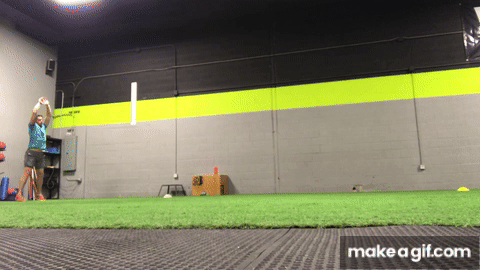
The double leg hop (also known as the standing broad jump) is similar to the squat jump, except you jump forward instead of straight up.
I know you’re probably going to get sick of hearing this by the end of this blog (if you’re not sick of it already), but I’m going to harp on it for as long as I coach: the key to minimizing the risk of injury while also improving performance is loading through your hips instead of your knees.
How it’s done: Sit back into your hips, keeping your chest up and eyes looking where you want to go. As mentioned before, this keeps your spine neutral. After loading through your hips, shift onto your toes and jump forward.
I recommend starting with a smaller jump (50-60% power) to get the feel for it. If it feels comfortable, progress to full power. Land like you would the squat jump: into your hips in an athletic position, as if you’re sitting on a bike.
Avoid these mistakes: Avoid landing through your knees, folding at your hips, and leaning/falling back. Keeping your chest over your toes is a simple mental cue to avoid landing through your knees. Just make sure your core is stable to keep this from happening to avoid folding at the hips.
Another common mistake with this movement is leaning back on your landing or falling backward. This happens when you reach your feet too far forward. The fix for this is the same as when we land through the knees – keep your chest over your toes.
3. Vertical, Horizontal, Vertical Jumps
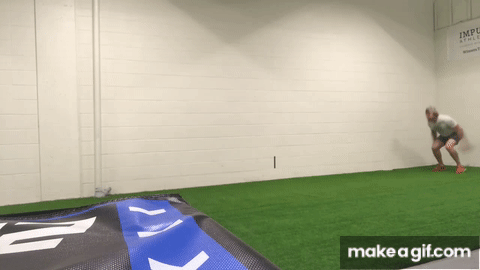
After you master squat jumps and double leg hops, combine the two and you get vertical, horizontal, vertical jumps. This is a fantastic progression because it teaches you how to manage and direct force (which is essential in all areas of athletics from running, playing recreational sports, or even just playing with children).
How it’s done: It’s easiest to break this drill down into simple pieces. Think of it as doing a squat jump into a double leg hop and finishing it off with another squat jump. So maybe a better name for this is squat jump, double leg jump, squat jump.
The key for this one is (you guessed it!) sitting into your hips.
Start tall and then load your body by sitting into your hips before jumping vertically. Land in an athletic position and jump forward (double leg hop). Land a second time (again through the hips) and jump vertically (squat jump).
Don’t do this: I often see athletes struggle with controlling their direction of force. This happens when you jump too far forward on the vertical jump and too high on the horizontal jump. Focus on traveling a minimal distance forward on the vertical jumps and a maximal distance on the horizontal jumps.
4. Lateral Hop

The previous exercises work your body in two dimensions (vertical and horizontal), but your body is healthiest when it’s training in all planes of motion. The lateral hop works your body moving side-to-side. It’s not a super common exercise people do, although it’s super beneficial from a loading standpoint.
How it’s done: I recommend setting up somewhere where there is a line on the ground (gymnasium, lined field, local track, etc.).
Pick a leg to start on (let’s say left) and lift the other foot off the ground. Jump from your left leg onto your right leg while staying on the line. Start at 60-70% max power to get a feel for it, and then build it up to max power while maintaining the lateral hop.
5. Single Leg Hop
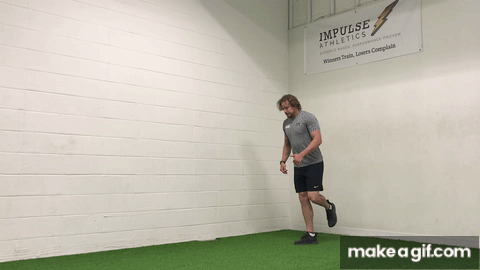
The single leg hop is a progression of the double leg hop/standing broad jump.
How it’s done: Pick a leg, load through the hip on that leg, and jump forward. Keep your eyes and chest up to maintain balance and prevent collapsing at the waist. Land on both feet after the jump in an athletic position.
Stay powerful: Make sure you load through your hip and push forward off the ground leg instead of swinging the off-leg through. Swinging the off-leg through is neither an efficient nor powerful way to jump with one leg, and it doesn’t allow you to stay in an athletic position.
If you want to generate maximum power (which I’m sure you do), work on cycling the take-off leg. This allows you to generate more momentum. As you progress the single leg hop to multiple single leg hops (which we’ll talk about later), the power compounds.
Final Thoughts
Plyometrics are a highly underutilized activity, especially for active adults. By incorporating these five plyometric exercises into your weekly workout routine, your performance in daily activities increases while your risk of injury decreases.
Try doing one (or all) of these moves a few days a week. Your bones, joints, ligaments, and tendons will thank you for it.
Find Your Perfect Training Plan
Sometimes all you need to reach your destination on your fitness journey is an expert guide. Look no further, we've got you covered. Browse from thousands of programs for any goal and every type of athlete.
Try any programming subscription FREE for 7 days!
Related Articles
You May Also Like...
Effective Ways to Coach At-Home Athletes
Transitioning to remote coaching presents unique challenges for strength and conditioning coaches, especially when athletes lack access to standard gym equipment. Effective communication and creative programming are essential to maintain engagement and ensure athletes...
Working Out During Ramadan: Maintaining & Making Gains
It’s falsely believed by many Muslim athletes that Ramadan = losing progress (gains!). This isn’t the case if you train, fuel, hydrate, and sleep appropriately. Of course that’s easier said than done, but following a few of these strategies can make all the difference...
5 Tips to Get Better at Strict Pull Ups
The ultimate bodyweight movement that even good athletes struggle with: pull ups. Getting your first strict pull up as a beginner is a huge accomplishment, but stringing multiple reps together is arguably just as huge. It can take time and some dedicated progressions...
Effective Ways to Coach At-Home Athletes
Transitioning to remote coaching presents unique challenges for strength and conditioning coaches, especially when athletes lack access to standard gym equipment. Effective communication and creative programming are essential to maintain engagement and ensure athletes continue to progress in their training.
Working Out During Ramadan: Maintaining & Making Gains
It’s falsely believed by many Muslim athletes that Ramadan = losing progress (gains!). This isn’t the case if you train, fuel, hydrate, and sleep appropriately. Of course that’s easier said than done, but following a few of these strategies can make all the difference...

Want more training content?
Subscribe
For Coaches
For Athletes
About
Support
Training Lab
Access the latest articles, reviews, and case studies from the top strength and conditioning minds in the TH Training Lab!
Made with love, sweat, protein isolate and hard work in Denver, CO
© 2024 TrainHeroic, Inc. All rights reserved.
